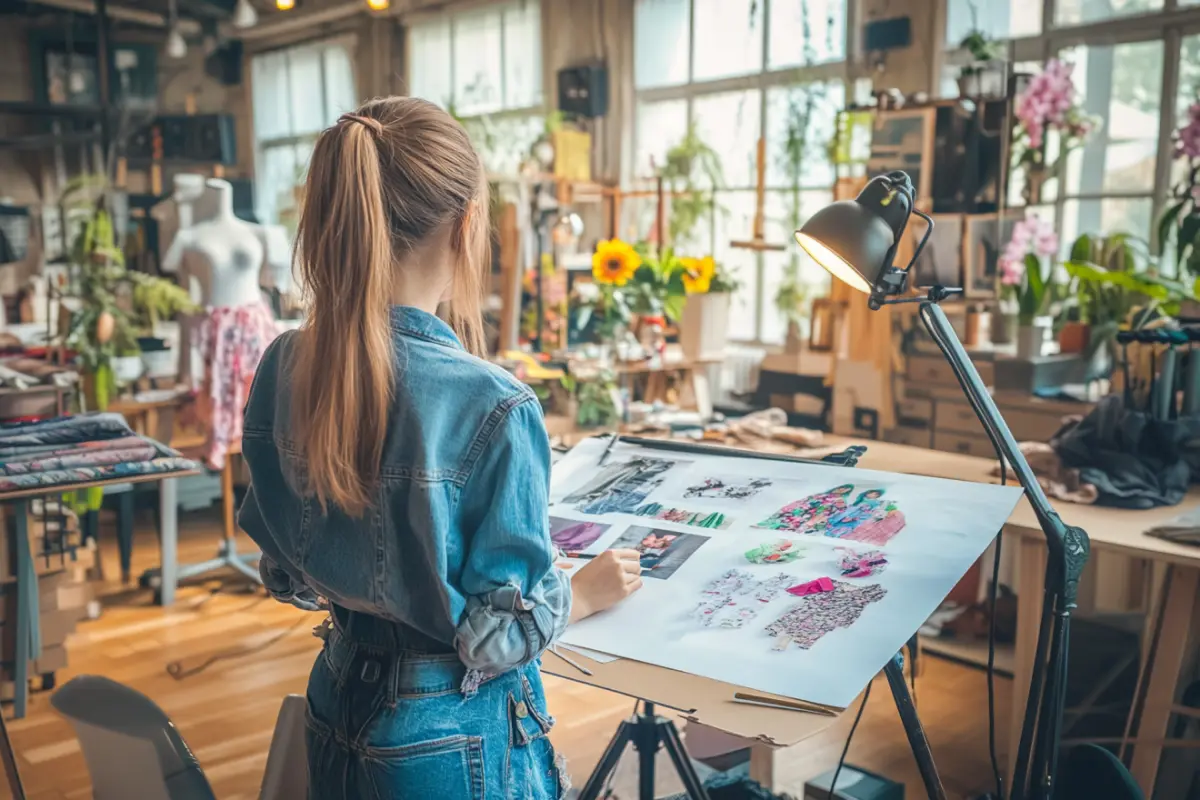
In the dynamic and visually-driven fashion world, creating a mood board is a foundational step for any creative project. Whether you’re a seasoned designer, a budding fashion entrepreneur, or someone exploring personal style, a fashion concept board serves as a powerful tool for organizing your ideas, refining your vision, and communicating that vision to others. The process of creating a moodboard for fashion design can be both intuitive and strategic, blending creativity with the structure to produce something that not only inspires but also guides your work.
A well-crafted fashion design mood board can set the tone for an entire collection, influence brand identity, or simply help you clarify your personal style using an outfit mood board. This guide will take you through everything you need to know to create your perfect fashion mood board, from defining your concept to choosing the best tools and techniques available today.
What is a Fashion Mood Board?
A fashion inspo board is a visual representation of a concept or idea, composed of images, color palettes, textures, patterns, and sometimes even text.
The purpose of a mood board is to capture the essence of a theme or vision in a cohesive and compelling way. Fashion designers, stylists, marketers, and even fashion enthusiasts use mood boards to explore and present their ideas before moving forward with a project.
For professionals in the fashion industry, mood boards are more than just a collage of pretty pictures — they are an essential part of the creative process. They help ensure that everyone involved in a project is on the same page, visually speaking. For individuals, mood boards can serve as a personal exploration of style, helping you to define and refine your aesthetic preferences.
The Importance of Fashion Mood Boards in the Industry
Mood boards are crucial in fashion for several reasons:
- Creative Direction: They guide the overall creative process, ensuring that the final output aligns with the original vision.
- Communication: They help communicate ideas to team members, clients, or stakeholders who may not be familiar with the technical aspects of fashion design.
- Inspiration: Mood boards can inspire new ideas and serve as a reference point throughout the project.
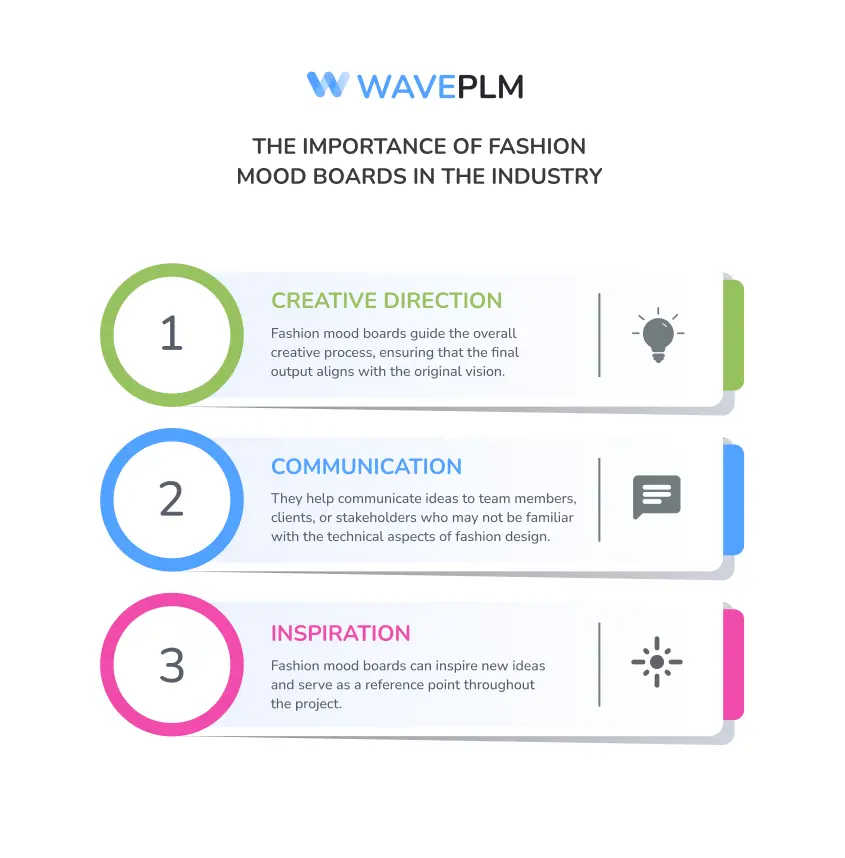
Step-by-Step Guide to Creating a Fashion Mood Board
Creating a mood board is both an art and a science. While there are no strict rules, following a structured approach can help you produce a more polished and effective board. So, here are the basic steps on how to make a fashion mood board.
Step 1: Define Your Concept
The first step in creating fashion boards is to define your concept clearly. This is the foundation upon which your entire board will be built. Your concept should be a specific theme or idea that you want to explore visually. It could be as broad as a seasonal trend like “Autumn/Winter 2024” or as specific as a “vintage 1950s Hollywood glam” look.
To define your concept, ask yourself the following questions:
- What message or mood do I want to convey?
- What colors, textures, or styles come to mind when I think of this concept?
- Who is the target audience for this mood board?
- Is it just a clothes mood board or a professional fashion mood board?
Once you have a clear concept, it will guide all the subsequent steps, from selecting images to organizing your board.
Step 2: Gather Inspiration
With your concept in mind, the next step is to gather materials that will populate your mood board. This is where you start collecting images, fabrics, color swatches, and other visual elements that resonate with your theme. The sources of inspiration are limitless—fashion magazines, runway shows, social media platforms, photography, nature, and even daily life can provide valuable material.
Here are some tips for gathering inspiration effectively:
- Diverse Sources: Don’t limit yourself to fashion alone. Look at art, architecture, interior design, and even film for inspiration. These different perspectives can enrich your mood board.
- Use Digital Tools: Platforms like Pinterest or mood board-specific apps can help you collect and organize your inspiration. Keywords like “fashion mood board app” will lead you to tools that are designed specifically for this purpose.
- Think Textures and Patterns: Don’t just focus on images—consider adding swatches of fabric, textures, and patterns to your board. These elements add depth and dimension to your concept.
Step 3: Organize and Assemble
After you’ve collected all your materials, it’s time to start organizing them. This is where your creativity and strategic thinking come into play. The goal is to arrange your images, swatches, and other elements in a way that tells a coherent and compelling story.
Here’s how to effectively organize and assemble your mood board:
- Focus on Flow: Think about how your audience’s eye will travel across the board. Start with a central image or concept, and build around it. Make sure there’s a natural flow from one element to the next.
- Balance Colors and Textures: Ensure that there’s a balance of colors, textures, and patterns. Avoid clustering similar elements together; instead, spread them out to create visual interest.
- Layering: Use layering techniques to add depth to your board. For example, place a fabric swatch partially over an image or layer text over a color block.
Whether you’re working with a physical board or a digital platform, the principles of good design remain the same. The arrangement should be aesthetically pleasing and should clearly communicate your concept.
Step 4: Review and Refine
Once your mood board is assembled, take a step back and review it critically. This step is crucial because it allows you to refine your board and ensure that it effectively conveys your intended message. Ask yourself the following questions:
- Does the board clearly represent the concept I had in mind?
- Is there a coherent flow, or do some elements feel out of place?
- Is the color palette harmonious, or are there clashing elements?
- Does the board evoke the intended mood or feeling?
Professional Tip: It can be incredibly helpful to get feedback from others at this stage. Whether it’s from a colleague, a mentor, or even friends, another set of eyes can provide valuable insights and help you see things you might have missed.
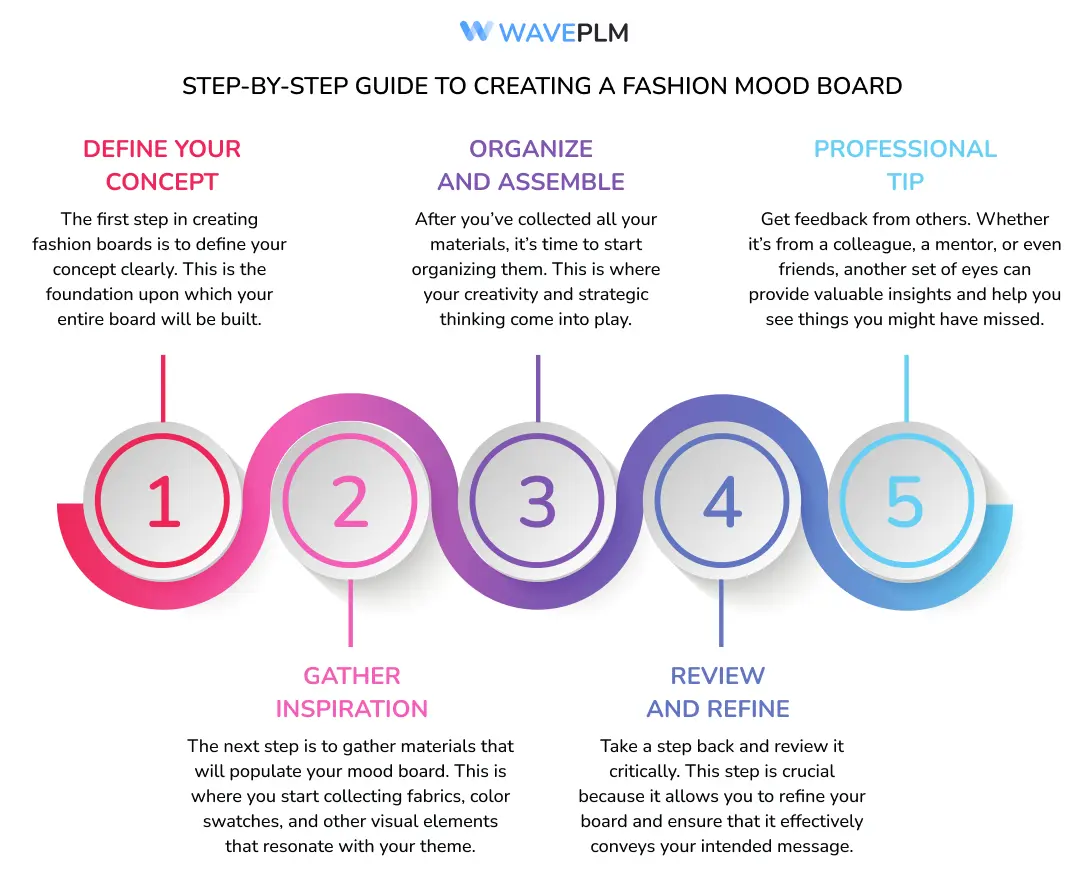
Best Tools for Creating Fashion Mood Boards
In today’s digital world, creating a mood board doesn’t have to be a time-consuming process. There are several tools available that can streamline the process and allow you to produce professional-quality mood boards with ease.
Here are some of the best tools for creating fashion mood boards:
- Canva: This user-friendly tool offers a wide range of templates that can be customized to suit your needs. Canva is ideal for beginners who want to create a polished mood board without spending too much time on the technical details.
- Pinterest: A fantastic platform for gathering inspiration, Pinterest allows you to create boards where you can pin images, articles, and even videos that align with your concept. It’s also a great way to discover new ideas and trends because Pinterest is full of fashion art moodboard templates.
- Adobe Spark: For those with a bit more experience, Adobe Spark offers advanced features that allow for greater customization. It’s a professional-level tool that can produce highly detailed and complex mood boards.
- Milanote: Known for its flexibility, Milanote allows you to create mood boards that incorporate not just images, but also notes, links, and even files. This tool is particularly useful for collaborative projects where multiple team members contribute to the board.
Using a fashion mood board app can significantly reduce the time it takes to gather inspiration and organize your board. These design tools are designed with creatives in mind, offering features that make it easy to adjust and refine your board as your project evolves.
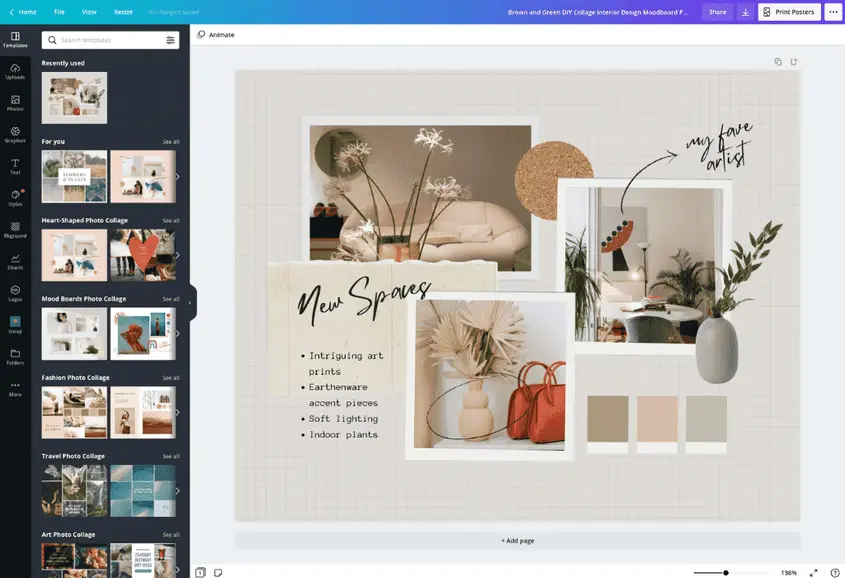
Some fashion brands utilize collection mood boards within their apparel management software, such as Fashion PLM (Product Lifecycle Management) systems. These digital mood boards are instrumental in organizing line lists for upcoming seasons, capturing inspiration, and streamlining the creative process for various projects.
For instance, in Wave PLM, you can effortlessly drag and drop images into the Line List module to gather inspiration and fashion trends. With just one click, these ideas can be seamlessly transformed into a product in real-time.
Conclusion
A fashion mood board is a vital tool in any fashion project, whether you’re designing a new collection, planning a photo shoot, or exploring your personal style. By following the steps outlined in this guide — defining your concept, gathering inspiration, organizing your materials, and refining your board — you can create a mood board that not only captures your vision but also serves as a guiding light for your project.
Remember, the key to a successful mood board is not just in the images you choose but in how you arrange and present them. With the right tools and a clear vision, you can create a mood board that is both inspiring and practical, helping you to bring your fashion ideas to life.
So why wait? Start your fashion mood board today and take the first step towards realizing your creative potential. Whether you’re a professional in the industry or someone passionate about fashion, a mood board is an indispensable tool in your creative arsenal.

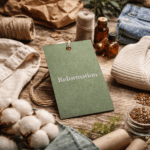



Leave a Reply